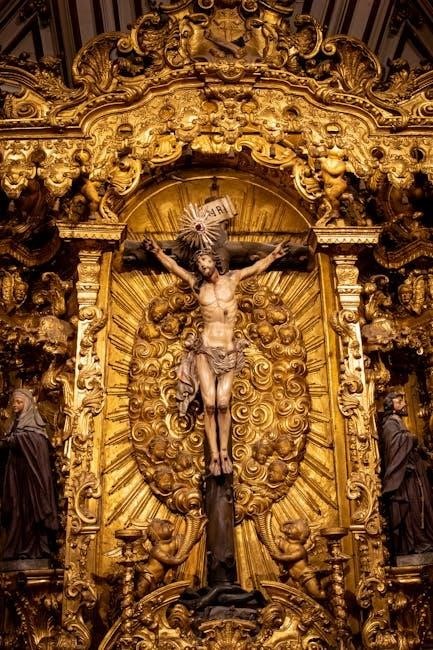The Stations of the Cross, a revered Catholic devotion, commemorate Jesus Christ’s final journey to Calvary. Traditionally consisting of 14 stations, this practice reflects on key events from His condemnation to crucifixion, offering spiritual reflection and connection to His Passion. The Stations are not strictly biblical but serve as a visual and meditative pathway for believers to deepen their faith. Available in various formats, including PDF guides, this devotion remains a powerful tool for personal and communal worship, especially during Lent and Holy Week.
1.1 What Are the Stations of the Cross?
The Stations of the Cross, also known as the Way of the Cross, are a series of 14 devotional reflections commemorating key events in Jesus Christ’s Passion, from His condemnation to His burial. Originating from the pilgrims who retraced Jesus’ journey in Jerusalem, this practice has evolved into a universal Catholic devotion. Each station represents a specific moment in His final hours, inviting believers to meditate on His suffering and redemption. The Stations are not strictly biblical but blend scripture, tradition, and spiritual reflection, offering a visual and prayerful pathway to deepen one’s connection to Christ’s sacrifice. They are often accompanied by prayers and available in PDF guides for personal or communal worship.
1.2 Purpose and Significance
The Stations of the Cross serve as a profound spiritual tool for believers to reflect on Christ’s Passion and its redemptive power. They invite individuals to meditate on His suffering, fostering empathy and gratitude for His sacrifice. This devotion deepens faith by connecting personal struggles to Christ’s journey, encouraging believers to embrace their own crosses with courage and humility. The Stations also promote communal worship, uniting people in prayer and reflection, especially during Lent. Their significance lies in their ability to transform sorrow into hope, reminding believers of the ultimate triumph of love and redemption through Christ’s resurrection. This practice remains a cornerstone of Catholic spirituality.

Historical Background
The Stations of the Cross trace their origins to early Christian pilgrims visiting Jerusalem, retracing Jesus’ path to Calvary. This devotion, rooted in the 4th century, originally involved physical journeys and evolved over centuries into the 14-station format widely practiced today.
2.1 Origins of the Devotion
The Stations of the Cross originated with early Christian pilgrims who visited Jerusalem to trace Jesus’ path to Calvary. This practice, dating back to the 300s, allowed believers to connect deeply with His Passion. Initially, the devotion involved physical journeys to the actual sites, reflecting on events as described in Scripture. Over time, the tradition evolved, and by the Middle Ages, it had spread to churches worldwide, adapting to local customs while maintaining its spiritual core. The Stations became a universal Catholic devotion, offering a tangible way to meditate on Christ’s sacrifice, fostering empathy and spiritual growth among the faithful.
2.2 Evolution Over the Centuries
The Stations of the Cross have evolved significantly since their inception. Early pilgrims in Jerusalem retraced Jesus’ path, creating informal devotional practices. By the Middle Ages, the number of stations varied, but the core concept remained. In the 18th century, the Catholic Church standardized the 14 stations, blending biblical events with traditional narratives. This structure was formally endorsed, making the devotion accessible to all Catholics. Over time, the Stations adapted to cultural contexts while retaining their spiritual essence, becoming a universal practice during Lent and Holy Week, fostering reflection on Christ’s Passion and its enduring relevance to faith and daily life.

Structure and Components
The Stations of the Cross consist of 14 distinct stations, each representing a pivotal moment in Christ’s journey to Calvary. They include prayers, meditations, and reflections, guiding believers to connect deeply with His Passion. Available as downloadable PDF guides, these resources often feature scripture readings, hymns, and visual imagery, enriching the devotional experience for both personal and communal worship.
3.1 The 14 Stations
The Stations of the Cross are divided into 14 distinct moments, beginning with Jesus’ condemnation and ending with His burial. Each station reflects a specific event, such as Jesus taking up His Cross, His first fall, and His encounter with His mother. While not all stations are directly biblical, they are rooted in tradition and devotion. Many PDF guides detail these stations, offering prayers, meditations, and reflections to deepen spiritual engagement. These resources often include visual imagery, scripture passages, and hymns, making them a comprehensive tool for personal or communal worship. The stations provide a structured way to contemplate Christ’s Passion and its significance.
3.2 Key Elements of Each Station
Each station in the Stations of the Cross includes specific prayers, reflections, and meditations, often accompanied by scripture readings. The key elements consist of an opening prayer, a meditation on the event, and a closing prayer. Many PDF guides provide structured formats, including hymns and visual imagery to enhance worship. These elements help believers connect with Christ’s Passion, fostering spiritual growth and reflection. The stations are designed to inspire empathy, gratitude, and a deeper understanding of Christ’s sacrifice, making them a powerful tool for personal or communal devotion during Lent and Holy Week.

Spiritual Significance
The Stations of the Cross hold profound spiritual significance, offering a deeper connection to Christ’s Passion and fostering reflection on personal faith. They inspire empathy, gratitude, and devotion, guiding believers toward spiritual growth and reconciliation.
4.1 Reflection on Christ’s Passion
The Stations of the Cross invite believers to reflect deeply on Christ’s Passion, contemplating His suffering and sacrifice; Each station provides a moment to connect emotionally and spiritually with Jesus’ journey, fostering empathy and gratitude. This reflection encourages prayer and meditation, helping individuals to understand the redemptive love behind His crucifixion. By engaging with the Stations, believers can align their personal struggles with Christ’s experiences, finding strength and hope. The devotion serves as a powerful reminder of God’s love and the transformative power of sacrifice, guiding followers to live with compassion and faith. It is a pathway to spiritual renewal and deeper discipleship.
4.2 Connection to Personal Faith Journey
The Stations of the Cross deeply connect with one’s personal faith journey by inviting reflection on Christ’s Passion and its relevance to individual struggles. Each station mirrors life’s challenges, urging believers to align their experiences with Christ’s journey. This devotion fosters empathy, gratitude, and spiritual growth, helping individuals confront their own crosses with courage. By meditating on Christ’s sacrifice, believers can deepen their relationship with God, embracing redemption and hope. The Stations offer a pathway to self-reflection, encouraging followers to live with compassion and resilience, drawing strength from Christ’s love. This practice becomes a powerful tool for personal transformation and spiritual renewal.

Different Versions and Adaptations
The Stations of the Cross exist in various forms, from traditional to modern interpretations, reflecting diverse cultural and artistic expressions. PDF guides offer accessible versions for personal devotion.
5.1 Traditional vs. Modern Interpretations
Traditional Stations of the Cross emphasize the historical and biblical narrative, often depicted through classic artwork and formal prayers. Modern interpretations adapt the devotion to contemporary contexts, incorporating diverse artistic styles and addressing current societal issues. While traditional versions focus on the physical journey of Christ, modern adaptations may simplify language or reflect personal faith experiences. Some modern interpretations also include reflections on social justice or environmental themes, making the Stations more relatable to today’s challenges. Both approaches aim to deepen spiritual connection, with traditional methods emphasizing sacred tradition and modern versions fostering personal relevance and accessibility for diverse audiences.
5.2 Variations Across Cultures
The Stations of the Cross have been adapted across cultures, reflecting local traditions and artistic styles. In African communities, Jesus is often depicted wearing traditional garments, while Asian interpretations incorporate symbols like lotus flowers. Indigenous cultures blend native rituals with Christian devotion. Latin American countries often celebrate with elaborate processions, known as “Via Crucis,” combining drama and music. These variations enrich the devotion, making it relatable to diverse populations. Art styles also differ, ranging from classical to modern interpretations. Despite these cultural adaptations, the core focus remains on Christ’s Passion, uniting believers worldwide in shared faith and reflection.

Praying the Stations of the Cross
Praying the Stations of the Cross involves a reflective journey through Christ’s Passion. Begin with an opening prayer, then move sequentially through each station. At each station, read the corresponding Scripture, reflect on its meaning, and pray. Many use PDF guides for structured devotion, including prayers and meditations. The practice fosters spiritual connection and personal growth, encouraging believers to contemplate Christ’s sacrifice and its relevance to their lives. This devotion is particularly meaningful during Lent, offering a profound way to deepen faith and humility.
6.1 Steps for Personal Prayer
Begin with an opening prayer, expressing devotion and intent. Move sequentially through each station, pausing to reflect on its significance. Read the Scripture associated with each station, then pray, using provided prayers or personal reflections. Kneeling or making the sign of the cross can enhance reverence. Use a PDF guide for structured prayers and meditations. After each station, take a moment of silence to internalize the moment. Conclude with a closing prayer, thanking God for the grace to follow Christ’s path. This personal pilgrimage fosters spiritual growth, inviting deeper connection with Christ’s Passion and its relevance to daily life.
6.2 Group Worship Practices
Group worship during the Stations of the Cross fosters communal reflection and shared devotion. Typically led by a minister or leader, the service begins with an opening prayer. Participants move collectively through each station, pausing for readings, reflections, and prayers. Hymns or antiphons, such as the Stabat Mater, may be sung between stations to enhance unity. The leader recites prayers, and the congregation responds with refrains like, “We adore you, O Christ, and we bless you.” This structured format encourages active participation and collective meditation on Christ’s Passion. Many churches provide PDF guides for worshippers, ensuring everyone can follow along seamlessly. The practice culminates in a final prayer and blessing, deepening the community’s spiritual connection.

Role in Lent and Holy Week
The Stations of the Cross are a central part of Lenten devotion, fostering reflection on Christ’s Passion. They hold special significance on Good Friday, connecting believers to His ultimate sacrifice and redemption.
7.1 Observance During Lent
The Stations of the Cross are a vital part of Lenten observance, offering believers a profound way to reflect on Christ’s Passion. Typically prayed weekly, they deepen devotion through meditation and prayer. Many churches provide PDF guides with structured reflections, including opening prayers and scripture readings. These resources enrich the spiritual journey, fostering a deeper connection to Christ’s sacrifice. The practice encourages both personal and communal worship, helping individuals to contemplate their faith and align their lives with the values exemplified by Jesus’ journey to Calvary. This tradition remains a cornerstone of Lenten spirituality, guiding believers toward renewal and reconciliation.
7.2 Special Significance on Good Friday
Good Friday holds profound significance as it commemorates Jesus Christ’s crucifixion, aligning deeply with the Stations of the Cross. This day intensifies the spiritual reflection, as believers vividly relive Christ’s Passion. The Stations of the Cross PDF guides often highlight the connection between the 14 stations and the events of Good Friday, providing structured prayers and meditations. Many churches offer special services, incorporating the Stations to deepen devotion. The practice becomes a communal and deeply spiritual experience, bridging the gap between Christ’s sacrifice and personal faith journeys. On Good Friday, the Stations serve as a poignant reminder of redemption and divine love.

Modern Adaptations and Innovations
The Stations of the Cross have evolved with contemporary art, digital formats, and virtual experiences. PDF guides and online resources now make this devotion accessible globally, fostering spiritual engagement through modern technology and creative interpretations.
8.1 Contemporary Art and Media
Contemporary art and media have transformed the Stations of the Cross into dynamic, visually compelling experiences. Digital formats, including PDF guides, now offer vibrant illustrations and interactive reflections. Artists use diverse mediums, from paintings to sculptures, to depict each station with fresh perspectives. Virtual exhibitions and online platforms allow global access, making the devotion more inclusive. Social media and apps further enhance engagement, enabling believers to reflect on the Passion of Christ through multimedia. These innovations ensure the Stations remain relevant, blending tradition with modern creativity to inspire spiritual contemplation and emotional connection during Lent and beyond.
8.2 Digital and Virtual Stations
Digital and virtual Stations of the Cross provide accessible and innovative ways to engage with the devotion. Online platforms and apps now offer virtual pilgrimages, allowing individuals to meditate on each station remotely. PDF guides are downloadable, enabling personal reflection anytime. Virtual reality experiences immerse users in Jerusalem’s Via Dolorosa, enhancing emotional connection. Social media campaigns share reflections and prayers, fostering a global community. These digital tools cater to modern lifestyles, ensuring the timeless tradition remains relevant. They also accommodate those unable to attend physical services, making the Stations of the Cross accessible to all, regardless of location or circumstance.

PDF Resources and Guides
Downloadable PDF guides for the Stations of the Cross offer structured prayers, meditations, and images. These resources provide accessible tools for personal reflection and communal worship, enhancing devotion.
9.1 Availability of Downloadable PDFs
Downloadable PDFs of the Stations of the Cross are widely available online, offering convenient access to prayers, meditations, and visual guides. Many Catholic churches and religious organizations provide free PDF resources on their websites, including bilingual versions for diverse congregations. These documents often feature traditional and modern interpretations, along with images and Scripture references. Users can easily find and download these guides from official Catholic portals, such as the Vatican website or reputable religious publishers. The PDF format ensures portability, allowing individuals to pray the Stations anywhere, making it a versatile tool for personal or group worship during Lent or any time of the year.
9.2 Features of Typical PDF Guides
Typical PDF guides for the Stations of the Cross include prayers, meditations, and reflections for each of the 14 stations. Many feature biblical passages, hymns, and chants to enhance worship. Visual elements like images or icons of each station are often included to aid meditation. Some guides offer bilingual texts, catering to diverse linguistic needs. Additionally, they may include opening and closing prayers, as well as instructions for praying the Stations individually or in groups. Modern versions often incorporate contemporary reflections on Christs Passion, making the devotion relevant to todays challenges. These guides are designed to be user-friendly, with clear layouts and navigation, ensuring a meaningful spiritual experience during Lent or any time of the year.
Stations of the Cross PDFs are comprehensive guides for prayer and reflection, helping believers connect with Christ’s Passion. They offer accessible resources for personal and communal worship, enriching spiritual journeys during Lent and beyond.
10.1 Summary of Key Points
The Stations of the Cross are a 14-step Catholic devotion reflecting on Christ’s Passion, from condemnation to resurrection. Originating from pilgrims retracing Jesus’ journey in Jerusalem, this practice has evolved over centuries. Each station combines prayer, meditation, and reflection, fostering a deeper connection to Christ’s sacrifice. Available in various formats, including PDF guides, these resources enhance personal and communal worship. They are particularly significant during Lent and Holy Week, offering a structured method for spiritual growth and contemplation. The Stations remain a powerful tool for believers seeking to honor Christ’s love and redemption through active devotion and prayerful engagement.

Additional Resources
For deeper exploration, downloadable PDF guides and online articles provide comprehensive insights, prayers, and reflections on the Stations of the Cross.
11.1 Recommended Reading and Links
FAQs
Q: What is the significance of the Stations of the Cross?
A: The Stations of the Cross are a devotion reflecting on Christ’s Passion, offering spiritual growth and connection to His sacrifice. Q: Where can I find Stations of the Cross PDFs? They are widely available online for download, often through religious websites or apps, providing guides for personal or group prayer.
12.1 Common Questions Answered
Q: What is the significance of the Stations of the Cross?
A: The Stations of the Cross are a devotion reflecting on Christ’s Passion, offering spiritual growth and connection to His sacrifice.
Q: Where can I find Stations of the Cross PDFs?
A: They are widely available online for download, often through religious websites or apps, providing guides for personal or group prayer.
Q: What is included in a Stations of the Cross PDF?
A: Typically, they include prayers, meditations, and reflections for each of the 14 stations, helping believers deepen their faith journey.
Q: Can I use these PDFs during Lent?
A: Yes, they are particularly meaningful during Lent and Holy Week, offering a structured way to reflect on Christ’s Passion.
These resources are invaluable for those seeking to enrich their spiritual practice through this timeless devotion.